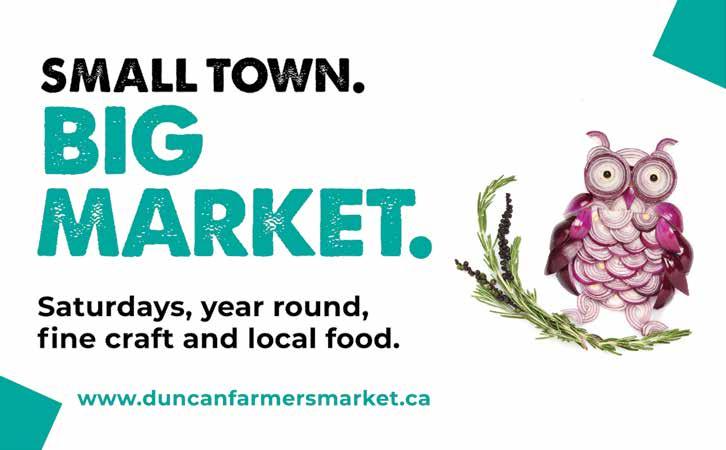
3 minute read
Cowichan Mushrooms

Tomato Pine Mushroom Compote
Advertisement
Courtesy Bill Jones, Deerholme Farm
2 cups (500 mL) chopped tomato 1 medium onion, peeled and diced 1 stalk celery, trimmed and diced ½ cup (125 mL) brown sugar ½ cup (125 mL) vinegar 1 Tbsp (15 mL) pickling spice 1 Tbsp (15 mL) minced ginger 2 cups (500 mL) minced pine mushrooms salt and pepper taste drizzle of olive oil (optional)
In a saucepan, combine the tomato, onion, celery, brown sugar, vinegar, pickling spice and ginger. Bring to a boil, reduce heat and simmer for 15 minutes or until the tomato breaks down, the vegetables are soft and the mixture has thickened. Add the minced pine mushrooms and cook for a further 15 minutes, or until the mushrooms have softened and the mixture is thick. Taste and season with salt and pepper to taste. You can now stir a little olive oil into the compote for extra richness.
Transfer to a glass jar with tight fitting lid. Can be stored in the fridge for up to one month. Excellent as a condiment for meats, roasted vegetables or on top of steamed rice. In my 21 years in the Cowichan I’ve been observing the ebb and flow of the mushrooms culture in the valley. This year has been rather slow in the mushroom foraging scene. The fall has been dry (until very recently) and the mushrooms are several weeks behind schedule. The warm rains of late October have helped and the season will pickup until we get the hard frosts of winter. The forests of our region are a rich source of good edible mushrooms with many more dangerous or simply inedible fungi thrown into the mix. The most abundant edible mushroom is probably the Chanterelle. There are several forms of the chanterelle present in the mossy forests floors of our region. Scientists have recently decided that the Pacific Golden Chanterelle (cantharellus formosus) is actually different from the European chanterelle and deserves it’s own name. This really illustrates how little we know about the world of mushrooms. Old ideas are being reevaluated as new technology like DNA analysis is brought to bear on things like our local mushroom crop. In our area, the main edible chanterelles are the yellow variety mentioned above and the white chanterelle – a close cousin with a pale
Twin Pine Mushrooms Courtesy Bill Jones Cowichan Mushrooms cream appearance and a thicker structure. The white is a great mushroom for chowders and I appreciate it for its mild flavour and abundance. There are lots of other good edible mushrooms out there, porcini, cauliflower fungus, hedgehogs and oyster to name a few. Only one other mushroom has a significant impact on the valley mushroom scene – the famous Pine Mushroom. Known as the Matsutaki in Japan, the pine has had a colourful history on the coast in recent years. Locally it has nothing to do with Pine trees (its favoured habitat in Japan) and likes our mixed forest of Douglas Fir and Hemlock. When it was first discovered here and exported to Japan, the prices climbed to astronomical levels. Three hundred dollars a pound was not an uncommon
price for these morsels. When other sources opened in Korea, Russia, Eastern North America (to name a few), the price dropped, in good production years, to about five dollars a pound. This year has not been a great harvest so far and the commercial wholesale price has risen to around fifty dollars for a pound of prime grade small buttons. As you can imagine there are some motivated local pickers out there.
Why the fuss over a small mushroom? The Japanese put great cultural significance into the pine mushroom. It’s a treasured part of their fall celebrations and beloved for its crisp texture and spicy (cinnamon-like) odor. I enjoy them in chowders, soups, rice dishes and noodle dishes. It also has a reputation as an aphrodisiac which, lets face it, doesn’t hurt.
We are lucky to be able to enjoy a delicacy that might cost the consumer hundreds of dollars per serving in Tokyo. Apparently, mushrooms are a world-class treat from our local forests – with the potential for significant economic impact. We have to view the forest as more than lumber farms to make this a reality. Enjoying the fungal bounty here in the Cowichan might be as easy as a trip to the woods - or the local farmers market.
Bill Jones is a chef, author and food consultant based on Deerholme Farm.












